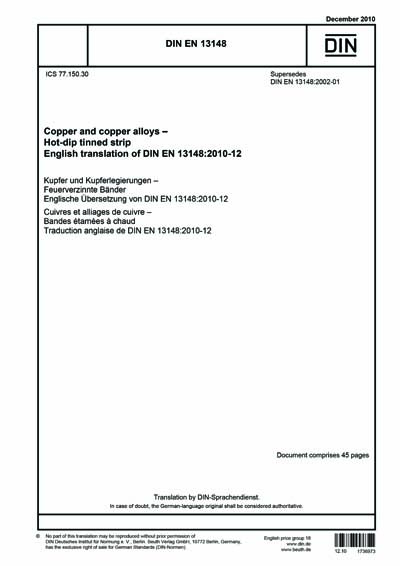Most recent
DIN EN 13148:2010
Copper and copper alloys - Hot-dip tinned strip; German version EN 13148:2010
This European Standard specifies:- the composition and tolerances on dimensions of strip in the thickness range from 0,10 mm up to and including 1,50 mm of copper and copper alloys to be tinned, with tin, a tin lead alloy or other tin alloys;- the composition of material normally used for the melt;- the properties of strip before tinning;- the properties of hot-dip tinned strip;- the preferred thicknesses (mean values) and thickness ranges of coatings;- the edgewise curvature of hot-dip tinned strip;- the sampling procedure;- the methods of test to be used for verification of conformity to the requirements of this standard;- the delivery conditions.*This standard specifies: - the composition and tolerances on dimensions of strip produced by rolling in the thickness range from 0,10 mm up to and including 1,50 mm of copper and copper alloys to be tinned, with tin, a tin lead alloy or other tin alloys; - the composition of material normally used for the melt - the properties of strip before tinning - the properties of hot-dip tinned strip - the preferred thicknesses (mean values) and thickness ranges of coatings - the edgewise curvature of hot-dip tinned strip - the sampling procedure - the methods of test to be used for verification of conformity to the requirements of this standard - the delivery conditions. Hot-dip tinned strips are manufactured by passing strips through a molten bath of tin, tin-lead alloy or other tin alloys. By this process a solid bond is created between the metallic coating and the strip by formation of a layer of an intermetallic layer. The base metal is hot-dip tinned to protect it against corrosion, to facilitate soldering operations, to improve insertion and withdrawal forces of connectors manufactured from strips, to reduce resistance at electrical junctions and to avoid whisker growth on components. The properties of coatings can be modified by mechanical and/or thermal treatments. When the strip is emerging from the bath the thickness of the coating is adjusted by partially wiping off the molten material sticking to the strip, either by stationary wiping devices or by a flat gas jet, preferably air. The thickness of the coating can be continuously measured and regulated on both sides of the strip immediately after the tinning process, usually with a device applying the X-ray fluorescence method. Usually strips are tinned in larger widths than ordered and slit to narrower width specified by the customer. In this case, the strips have untinned edges. The European Standard EN 13148:2010 has been prepared by CEN/TC 133 "Copper and copper alloys" (secretariat: DIN). Regarding the German collaboration the responsible Working Committee is NA 066-02-02 AA "Walzerzeugnisse" ("Rolled flat products") of FNNE.
Deutsches Institut für Normung [din]

